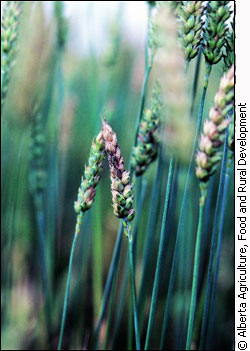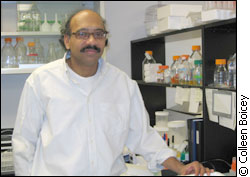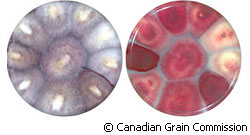
|
Once the disease, also known as wheat scab and tombstone disease, contaminates the plants, they can no longer be used as food or animal feed. In the 1990s, the United States lost $2.6 billion due to FHB, according the United States Department of Agriculture (USDA). "Fusarium blight or scab of wheat and barley has been the plant disease with arguably the greatest impact on U.S. agriculture and society," says the USDA's website. First discovered in England in 1884, the disease's impact is now felt globally. Canada has suffered economic losses since the 1940s, says the Canadian Grain Commission's website.
FHB can spread easily through blown or splashed spores, in crop residue after harvest, or even through infected plants which appear symptom-less. The disease affects both the quality and the yield of crops. One of the toxins it produces, Deoxynivalenol or DON, causes vomiting, refusal of food and diarrhoea if ingested by animals and nausea, poisoning and convulsions if ingested by humans. Determining how DON is produced in the fusarium fungus is what lies at the centre of Gopal Subramaniam's research. Subramaniam, PhD, a researcher at Agriculture and Agri-Food Canada in Ottawa, leads a team trying to map three genes and their respective proteins which contribute to the production of DON. Eventually, once scientists understand how DON is produced, the culprit genes and proteins may be able to be "turned off" through genetic modification, Subramaniam says. This could lead to the creation of a new, harmless organism which would replace the existing fungus with a strain unable to complete its life cycle and as a result, not pose a threat to plants. Process Subramaniam and his team are building on the work done by other researchers who have mapped 99.8 per cent of fusarium's genetic sequence. About 15 genes and their respective proteins help to produce DON. "Not a single gene contributes to the disease. There are many," Subramaniam says.
His team's research is different than most related to FHB because he focuses on the pathogen, the disease causing agent, while other researchers tend to study the plant's reaction to a fusarium invasion. Knowing both sides of the story is important to Subramaniam. "There's a bias towards the plant. We have to know what a pathogen does," he says. "We need to know both to attack the problem." In order to learn more, the team grows the fusarium on plates. They then use proteomics tools to isolate proteins. Proteomics is a form of biotechnology which helps analyze the structure, function and interactions of proteins in a cell. Once these proteins are isolated, they are monitored on a gel. Changes in the proteins are noted when there is a change in size of the round pieces of the protein, called peptides. If the peptides change size or shape, they are extracted and analyzed using a database to determine their genetic origin.The controversy There is controversy with any research that leads to genetically-modified organisms (GMOs), and this research is no different. There is concern among advocacy groups, scientists and the public that GMOs will contaminate other crops; are not regulated properly; and are also unethical because they interfere with nature. Some are worried the consequences of using GMOs are unknown and that the research is profit-driven, while ignoring environmental consequence. Others fear GMOs will be the new pesticides and willharm future generations.
Subramaniam explains that in nature, genetic modification has been occurring like a mysterious "black box" since the beginning of time. Today, instead of not knowing what has been modified, the scientist can be in control. "In GMOs, you know exactly which genes you are altering and you know where it's going to. We know exactly what we’re doing… we can study the consequences," he says. As a scientist, he also believes in testing GMOs because he pursues "science for science's sake." Social advocate Karen Hawley can appreciate this quest for knowledge, but fears it will only open the doors to GMOs. "It's the essential first step to something that is coming later. So, it's not that there's no value, but we can see where this is going. It's natural to want to explore. It doesn't mean we have to start modifying genes," says Hawley, a representative from the Ontario Public Interest Research Group. Doug Gurian-Sherman, PhD, a plant pathologist and a senior scientist at the Center for Food Safety in Washington, D.C., is concerned about genetic research because he feels it's hard to manipulate a set of genes without affecting others. "It's very hard to get those things to work out well." It's hard to know whether a new species will have an advantage compared to the old because of weak testing regulations in Canada and the U.S., he says. It’s also difficult to forecast any long-term health consequences because crops are not monitored for such effects. Also, since not all fields are infected, spraying all fields with a new strain could make the problem worse, and there could be more loss than had the fields been left unaltered, Gurian-Sherman says. He also says genetic research is detracting from other possible solutions such as agroecology techniques like organic farming, breeding and integrated pest management. The research is more "attractive to scientists" because genes can be turned off relatively easy compared to the process of developing agroecology techniques, Gurian-Sherman says.
Agreocology techniques cannot be commodified as easily because they rely on knowledge and expertise, so they do not receive the same funding gene manipulation projects do, he says. The success of genetically-modified crops is also overrated, he says. Since 1987, 11,000 field trials have been completed and there are only two crops which have been successful, bt and herbicide resistant crops. However, Gurian-Sherman does not entirely dismiss genetic modifications. "I think some of these applications could be potentially useful." But, it's important for scientists to realize the power of genes. "I think we're not quite humble enough in terms of the changes this may cause," he says. Challenges There are many steps ahead before Subramaniam's team gets to the controversial stage of modifying or "turning off" genes. Right now, when trying to determine which proteins regulate the production of DON, the possibilities seem endless because the team is taking a linear approach to examining the changes in the proteins. The reality though, in a cell, all the proteins are mixed together and the interactions between them are dynamic and in motion. "They are not sitting in an arrow, they are mixed in a protein soup," Subramaniam says. The team will have to consider all of the variables to determine under which circumstances the proteins come together and regulate the production of the toxin. "It's definitely laborious, it's hard." Subramaniam says a larger team would be able to accomplish the task faster. However, he knows once his portion of the research is complete he will be able to integrate it with the Agriculture and Agri-Food Canada's other teams, those working from the perspective of the plant, the environment and the field. Subramaniam and his team's work could eventually become the building blocks for a modern, but controversial solution, to FHB – a long-standing plant disease which is still devastating to the world's agricultural sector.
|
|
|


